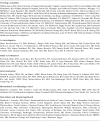Adherence to behavioral interventions for urge incontinence when combined with drug therapy: adherence rates, barriers, and predictors
- PMID: 20671098
- PMCID: PMC2949583
- DOI: 10.2522/ptj.20080387
Adherence to behavioral interventions for urge incontinence when combined with drug therapy: adherence rates, barriers, and predictors
Abstract
Background: Behavioral intervention outcomes for urinary incontinence (UI) depend on active patient participation.
Objective: The purpose of this study was to describe adherence to behavioral interventions (pelvic-floor muscle [PFM] exercises, UI prevention strategies, and delayed voiding), patient-perceived exercise barriers, and predictors of exercise adherence in women with urge-predominant UI.
Design: This was a prospectively planned secondary data analysis from a 2-stage, multicenter, randomized clinical trial.
Patients and intervention: Three hundred seven women with urge-predominant UI were randomly assigned to receive either 10 weeks of drug therapy only or 10 weeks of drug therapy combined with a behavioral intervention for UI. One hundred fifty-four participants who received the combined intervention were included in this analysis.
Measurements: Pelvic-floor muscle exercise adherence and exercise barriers were assessed during the intervention phase and 1 year afterward. Adherence to UI prevention strategies and delayed voiding were assessed during the intervention only.
Results: During intervention, 81% of women exercised at least 5 to 6 days per week, and 87% performed at least 30 PFM contractions per day. Ninety-two percent of the women used the urge suppression strategy successfully. At the 12-month follow-up, only 32% of the women exercised at least 5 to 6 days per week, and 56% performed 15 or more PFM contractions on the days they exercised. The most persistent PFM exercise barriers were difficulty remembering to exercise and finding time to exercise. Similarly, difficulty finding time to exercise persisted as a predictor of PFM exercise adherence over time.
Limitations: Co-administration of medication for UI may have influenced adherence.
Conclusions: Most women adhered to exercise during supervised intervention; however, adherence declined over the long term. Interventions to help women remember to exercise and to integrate PFM exercises and UI prevention strategies into daily life may be useful to promote long-term adherence.
Trial registration: ClinicalTrials.gov NCT00090584.
Figures





Comment in
-
Invited commentary.Phys Ther. 2010 Oct;90(10):1505-7; author reply 1507-9. doi: 10.2522/ptj.20080387.ic. Phys Ther. 2010. PMID: 20889929 No abstract available.
References
-
- Fantl JA, Newman DK, Colling J, et al. Urinary Incontinence in Adults: Acute and Chronic Management: Clinical Practice Guideline No. 2 Update. Rockville, MD: Public Health Service, Agency for Health Care Policy and Research, US Dept of Health and Human Services; 1996. Publication No. 96–0682
-
- Hannestad YS, Rortveit G, Sandvik H, Hunskaar S. A community-based epidemiological survey of female urinary incontinence: the Norwegian EPINCONT Study, epidemiology of incontinence in the County of Nord-Trondelag. J Clin Epidemiol. 2000;53:1150–1157 - PubMed
-
- Andersson KE. Antimuscarinics for treatment of overactive bladder. Lancet Neurol. 2004;3:46–53 - PubMed
-
- Burgio KL, Borello-France DF. Pelvic floor muscle exercises and behavioral therapy. In: Kreder K, Dmochowski R. eds. The Overactive Bladder: Evaluation and Management. London, United Kingdom: Informa Healthcare; 2007:86–94
-
- Fantl JA, Wyman JF, McClish DK, et al. Efficacy of bladder training in older women with urinary incontinence. JAMA. 1991;265:609–613 - PubMed
Publication types
MeSH terms
Associated data
Grants and funding
- U01 DK 58225/DK/NIDDK NIH HHS/United States
- U01 DK60393/DK/NIDDK NIH HHS/United States
- U01 DK058234/DK/NIDDK NIH HHS/United States
- U01 DK58234/DK/NIDDK NIH HHS/United States
- U01 DK060393/DK/NIDDK NIH HHS/United States
- U01 DK60379/DK/NIDDK NIH HHS/United States
- U01 DK060380/DK/NIDDK NIH HHS/United States
- U01 DK060397/DK/NIDDK NIH HHS/United States
- U01 DK60380/DK/NIDDK NIH HHS/United States
- U01 DK60395/DK/NIDDK NIH HHS/United States
- U01 DK060401/DK/NIDDK NIH HHS/United States
- U01 DK058229/DK/NIDDK NIH HHS/United States
- U01 DK060395/DK/NIDDK NIH HHS/United States
- U01 DK58229/DK/NIDDK NIH HHS/United States
- U01 DK60397/DK/NIDDK NIH HHS/United States
- U01 DK58231/DK/NIDDK NIH HHS/United States
- U01 DK060379/DK/NIDDK NIH HHS/United States
- U01 DK60401/DK/NIDDK NIH HHS/United States
- U01 DK058225/DK/NIDDK NIH HHS/United States
- U01 DK058231/DK/NIDDK NIH HHS/United States
LinkOut - more resources
Full Text Sources
Other Literature Sources
Medical

